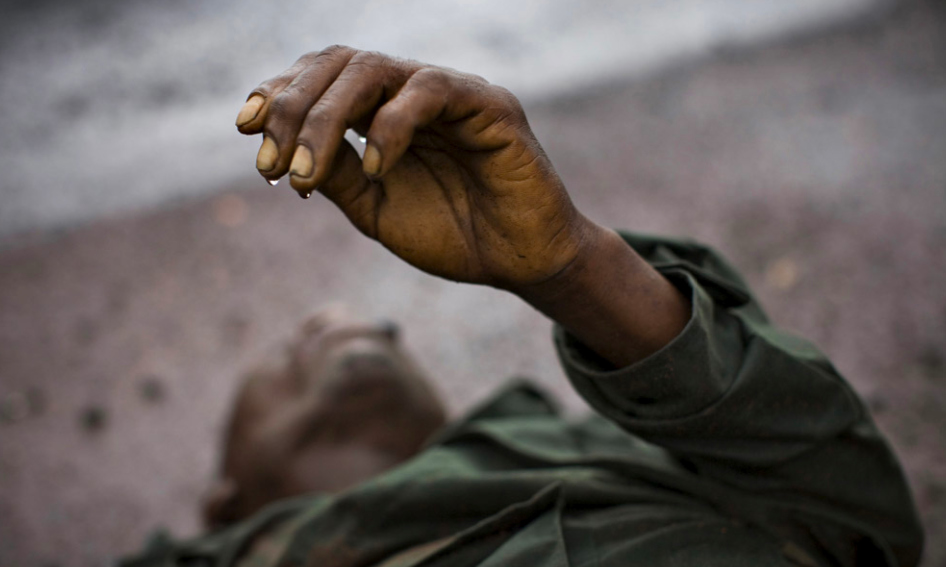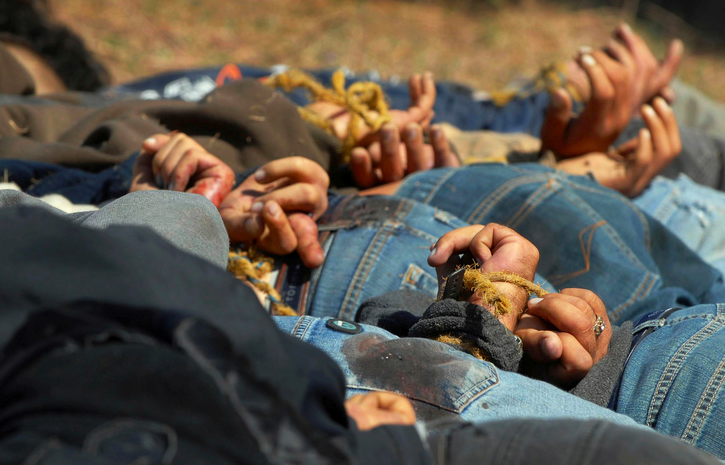Photojournalism is vexed by the problem of how to portray degradation and death without harming the dignity of those being photographed. The medium’s capacity for evoking emotional response and moral judgment cannot be separated from its ability to add insult to injury. With that problem in mind, one can appreciate why this photograph is not only striking but also an ethical achievement.
A Congolese government soldier lies dead in the road not long after having been shot in the head. He is one of many who have died or will die in the continuing violence in central Africa. It is easy to immediately think of him as a statistic. Another distant victim in yet another civil war, one about which the viewer probably has no interest, no knowledge, no connection. A war that becomes merely another example of the seemingly endless violence spreading through the jungles and across the deserts and up into the mountains around the globe as poor people are recruited to maim and kill one another for the benefit of unseen warlords.
Thus, it can be easy to dismiss him, except for that hand. There is something achingly beautiful about it. It seems so alive, or if we know otherwise, so etched with life. It is a particular hand, not the abstract symbol of labor, but the hand of an individual whose lifetime of experiences, however common, were encountered with all the particularity evident in each crease of skin, the line of each cuticle, the smudge of dirt. More than that, the image evokes all the skill of a hand, its capability for craft and communication. Caught in a last gesture, this hand seems to still want to communicate, to reach out or up, to plead, perhaps, or to touch and say goodbye.
We know that he is dead, however, and so the raindrops on the fingers become poignant. They course down his limb, set in rigor mortis, as they do on any other inanimate thing, and yet they still seem to signify life. As if he were still capable of bleeding, or of washing, as if he could perhaps be revived with cool water. But the point is not to keep hope alive. Rather, the hand offers mute testimony to the value of the life that has been lost. It presents him as an individual person but not merely because he had a name or a personality. And it records his death with dignity, suggesting how much has been lost without showing the devastation of the head wound.
Photojournalism can not be satisfied with avoiding habits of dehumanization, however, as it also has to confront and expose those practices in their worst forms, which are not done by shooting with a camera. This second photograph was in a number of slide shows recently, perhaps because it captures so well the gross destructiveness of war.
These are the hands of men executed near San Ignacio, Mexico. They are among the latest casualties in the border wars between Mexican drug cartels. (For a current report on the violence, see “Day of the Dead” in The Observer/The Guardian.) The photo documents the practice of tying up the victims, which in turn implies that this was a planned execution characteristic of high level gang warfare. It also captures the fact of murder without revealing the identities of the victims or the full violence done to their bodies.
These hands in this image accomplish something different from the work done in the first photograph. Where before dignity was salvaged from chronic violence, now the shameful nature of mass killing is exposed. These men were left this way to demean them, while the photograph exposes where the shame really lies–with those who kill, and with those could try to stop the killing but look the other way.
Equally important, now the implicit metonymy of hands signifying labor is rightfully in play. These men could have been productive laborers (and managers) had the work been available. Whatever bad choices they might have made, the narco-economy and its attendant carnage involves a terrible waste of human potential. The drug trade, like the arms trade, is a global business, and globalization can spread destructiveness just as easily as it can generate wealth. If hands could speak, these would beg to be given a second chance, one with real work that could lead to a better life.
The hands do speak. The question is, who is listening?
Photographs by Finbarr O’Reilly/Reuters (via The Big Picture) and the Associated Press.
Update: Thanks to Michael Shaw for the double post at BAGnewsNotes, where you can read additional comments by readers there.


Collateral damage in the war against drugs.
No. You are racist in broadcasting American politics on this African war. They have their reasons. They are people. They can hate without whites making them hate. To strip them of original sin is the lasting effect of the Christian Religion and the animalization of non-whites.
The thing that keeps catching my eye in the second photo is the ring worn on the hand at bottom right. I find it to be the most distinctive thing in the image: none of the other hands I can see have one. It makes me remember that yes, these were individuals with their own lives, brutally interrupted.
I also must wonder why the ring remains, why the killers did not also rob their victims, as is so often the case. It’s an impossible question to answer, but as you point out, the photo itself is, as well.
Your weeping hand — surely, those are tears! — brought to mind the verses from Isaiah which I first encountered as a child, on a memorial card at a funeral: See! I shall not forget you. I have carved you on the palm of my hand.
It is the coarse twine in the second photo that I find so disconcerting, for nothing in the image connects the dead hands of the victims to the invisible hands of the perpetrators more than those parceled wrists. Knotting and tying are tasks for which our human hands are uniquely suited. These hands were bound by other hands. Sometimes, as in the first photo, the evidence of human involvement, the “how we know” the death was at the hands of a fellow human, lies beyond the image. The twine is witness to the direct hand-to-hand contact that preceded and facilitated these executions. And, as I imagine the thousands of parcels that will be expertly wrapped, bow-tied and securely fastened by countless nimble fingers, moving quickly in the rush of the season…the image is indeed a brutal interruption.
[…] I got somewhat lyrical about two images of “Hands of Death.” Now we are looking at the foot of a suicide bomber in Afghanistan. Rather than speak about […]
[…] of something we should have known about. Or it could be another testament to lives lost, marked by hands of death. Or we could see it as a further instance of the indirect marking of mass death, preserving dignity […]
I will let you know that a majority of the dead in the Mexican states are people involved in the drug business. Once these killings begin it’s a never ending cycle because they (the cartels) need to save face and cannot just walk away when their street level dealers are mutilated. As for the African wars, a big number of Africans are still at the height of raw human behavior, this is why for them violence guns, and killing is the only solution. It will take a couple of decades more for them to start using words instead of violence. I don’t blame them have you seen African leaders, they look good, marry the best, and have the most. So of course it’s something worth fighting for.
[…] of something we should have known about. Or it could be another testament to lives lost, marked by hands of death. Or we could see it as a further instance of the indirect marking of mass death, preserving dignity […]
[…] A Commentary On Mexico’s Drug Cartel War And It’s Impact On The U.S. (Arizona Included) Three bodies lie in a Tijuana street during 72 hours of ferocious street battles between drug cartels. Photograph: Sergio Ortiz […]